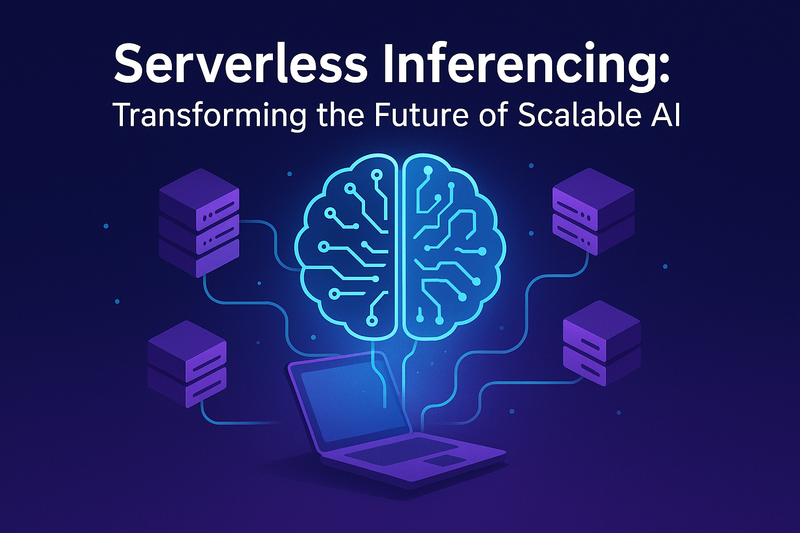Artificial Intelligence (AI) has evolved rapidly in just a few years, fueling innovations across industries from healthcare and finance to retail and logistics. As demand for intelligent applications grows, developers and enterprises face a persistent challenge: how to deploy AI models at scale, while keeping infrastructure complexity and costs manageable. This is where serverless inferencing is beginning to play a vital role.
Traditionally, deploying AI models required maintaining dedicated servers or cloud environments that remain active 24/7 to respond to inference requests. For organizations with fluctuating demand, this often resulted in wasteful resource utilization and unnecessary expenses. Serverless inferencing addresses these limitations by combining the scalability of serverless computing with the power of AI model predictions, offering on-demand performance without heavy operational overhead.
What is Serverless Inferencing?
Serverless inferencing refers to the execution of AI model predictions (or inferences) using a serverless computing framework. In a serverless setup, developers do not manage servers directly. Instead, the cloud provider automatically provisions, scales, and manages compute resources as requests arrive.
When applied to AI, this means a machine learning model can be deployed as a lightweight function that executes only when triggered by user queries, application events, or API calls. For example, instead of keeping a GPU-powered instance running continuously, the model is invoked only when a request comes in, and the infrastructure scales up to handle it.
This approach eliminates a significant amount of wasted compute time, while also making it cost-efficient for businesses that deal with unpredictable workloads.
Why Serverless Inferencing Matters
The adoption of serverless inferencing is not just a minor optimization; it represents a fundamental shift in how AI workloads can be consumed. Here are the main reasons why it matters:
1. Scalability Without Hassle
AI-driven applications such as recommendation engines, chatbots, fraud detection systems, and image recognition platforms often experience bursts of traffic. With serverless inferencing, the infrastructure automatically scales up to handle peak requests and scales back down during idle times. This elasticity ensures that no resources are oversubscribed or underutilized.
2. Cost Efficiency
One of the biggest attractions of serverless architecture is the pay-as-you-go billing model. Organizations only pay for the actual compute time used during inference requests. For seasonal businesses or applications with unpredictable demand, this has the potential to significantly reduce operational expenses compared to maintaining always-on infrastructure.
3. Simplified Operations
Managing servers for AI deployments requires specialized knowledge of containerization, load balancing, autoscaling, and monitoring. Serverless inferencing abstracts away these complexities, letting developers focus on refining models and improving functionality instead of wrestling with infrastructure.
4. Rapid Experimentation and Deployment
For data scientists and engineers, speed matters. Serverless inferencing enables quick deployment of multiple models for testing, without the delay of provisioning and configuring dedicated resources. This agility supports innovation and faster time-to-market for AI-driven features.
Use Cases of Serverless Inferencing
Serverless inferencing is making its mark across varied industries. Some practical use cases include:
- Healthcare Applications: AI-powered medical imaging systems that assist radiologists can run inference requests only when new scans are uploaded, reducing unnecessary compute costs.
- Retail and E-commerce: Recommendation engines and personalization models can dynamically scale with traffic spikes during sales or festive seasons.
- Financial Services: Fraud detection models that analyze transactions in real time benefit from on-demand scaling, ensuring accurate and quick predictions without keeping dedicated servers running.
- Customer Support: Chatbots and virtual assistants powered by NLP models can leverage serverless inferencing for round-the-clock availability without idle infrastructure.
Challenges to Consider
Despite its advantages, serverless inferencing is not without trade-offs. Organizations need to be mindful of factors such as:
- Cold Start Latency: Since serverless functions spin up on demand, the first request after idle periods can experience delays. This may be problematic for latency-sensitive applications.
- Resource Limits: Cloud providers impose limits on memory, execution time, and concurrent executions. Large-scale models may need optimizations or partitioned deployments to fit within these constraints.
- Model Size and Dependency Management: Deploying large deep learning models in a serverless environment requires careful packaging and optimization to ensure smooth execution.
- Vendor Lock-In: Relying on specific serverless frameworks may increase dependency on a single cloud provider. Multi-cloud portability requires additional planning.
Best Practices for Serverless Inferencing
To get the best out of serverless inferencing, teams should adopt certain practices:
- Optimize and Compress Models: Techniques such as quantization, pruning, and knowledge distillation can reduce model size, making them more suitable for serverless deployment.
- Leverage Event-Driven Architectures: Design inference pipelines around events, such as a new user request or a file upload, to maximize the benefits of serverless execution.
- Use Specialized Frameworks and Tools: Several cloud providers now offer managed services for serverless inferencing (such as AWS Lambda with AI model integration or Google Cloud Functions). Evaluating these options can save significant development effort.
- Plan for Hybrid Architectures: For applications where both high throughput and low latency are essential, a hybrid system combining serverless inferencing with dedicated GPU instances might be effective.
The Road Ahead
As AI models continue growing in size and complexity, the need for scalable yet efficient deployment strategies will intensify. Serverless inferencing is an emerging paradigm that promises to lower operational barriers while expanding accessibility to advanced machine learning capabilities.
For small startups, this can mean deploying AI-driven products without major infrastructure investments. For large enterprises, it offers elasticity to handle global-scale demand while optimizing costs. Over time, improvements in serverless platforms—such as reduced cold start latency, GPU-backed functions, and support for larger models—are likely to make this approach even more compelling.
Conclusion
Serverless inferencing is more than just a technical advancement; it is a practical bridge between AI innovation and real-world, scalable deployment. By marrying the flexibility of serverless computing with the intelligence of machine learning, it empowers developers and organizations to deliver smarter applications with less effort and expense.
As adoption grows, serverless inferencing is poised to become a cornerstone in the AI deployment toolkit, changing how businesses bring intelligence to their products and services.




Top comments (0)